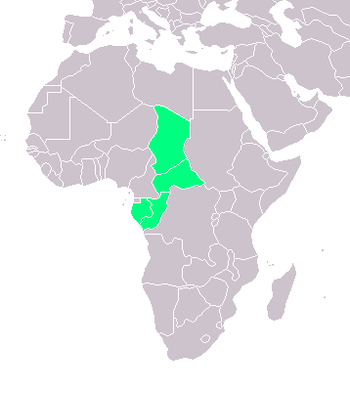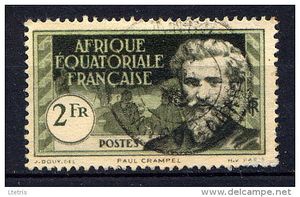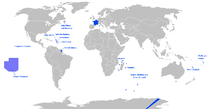أفريقيا الإستوائية الفرنسية
أفريقيا الإستوائية الفرنسية Afrique équatoriale française | |||||||||||||||||||||||||
|---|---|---|---|---|---|---|---|---|---|---|---|---|---|---|---|---|---|---|---|---|---|---|---|---|---|
| 1910–1958 | |||||||||||||||||||||||||
 | |||||||||||||||||||||||||
| المكانة | اتحاد المستعمرات الفرنسية | ||||||||||||||||||||||||
| العاصمة | برازاڤيل | ||||||||||||||||||||||||
| اللغات الرسمية | الفرنسية | ||||||||||||||||||||||||
| الدين | الكاثوليكية الرمانية | ||||||||||||||||||||||||
| الحاكم العام | |||||||||||||||||||||||||
• 1908-17 | مارشال هنري مرلان | ||||||||||||||||||||||||
• 1951-57 | پول لوي گابرييل شوڤيه | ||||||||||||||||||||||||
| المفوض السامي | |||||||||||||||||||||||||
• 1957-58 | پول لوي گابرييل شوڤيه | ||||||||||||||||||||||||
• 1958 | پيير مسمير | ||||||||||||||||||||||||
| التاريخ | |||||||||||||||||||||||||
• تأسست | 15 يناير 1910 | ||||||||||||||||||||||||
• انحلت | سبتمبر 1958 | ||||||||||||||||||||||||
| Currency | فرنك أفريقيا الإستوائية الفرنسية CFA franc | ||||||||||||||||||||||||
| |||||||||||||||||||||||||
إفريقيا الاستوائية الفرنسية فرنسية: L'Afrique-Équatoriale française AEF اتحاد من أربع مناطق في إفريقيا الوسطى، تأسس سنة في 1910 ، كان يمتد من نهر الكونغو إلى الصحراء الكبرى. كانت تديره الدولة المستعمرة فرنسا. ويُكوّن هذا الاتحاد اليوم أربع دول مستقلة وهي جمهورية إفريقيا الوسطى وتشاد والكونغو (الكونغو الفرنسية) والجابون. كانت تغطي المنطقة مساحة 2,509,994 كم² ومعظم الناس في هذه المنطقة أفارقة سود. وتعيش الشعوب المتحدثة بالبانتو في الجنوب، أما جماعات الفولا والسارا والتوبو فكانت تعيش في الشمال.
وفي المنطقة موارد كثيرة من الغابات والمعادن، وتقع أغنى مستودعات المعادن المعروفة في دولة الجابون. وتتضمن المنتجات الرئيسية القطن والأرز واللحوم والفول السوداني والكاكاو والبن والخشب والمنجنيز والزيت. وقد وصل المستعمرون الفرنسيون الأوائل إلى إفريقيا عام 1839م واستقروا على ضفاف نهر الجابون، وفي عام 1849م، أسسوا ليبرڤيل وجعلوها عاصمة للمستعمرة ثم انتقلت العاصمة بعد ذلك إلى برازافيل. وقد مُنحت المناطق الأربع لإفريقيا الاستوائية الفرنسية الفرصة لأن تُصبح جمهوريات مستقلة في نوفمبر عام 1958م. وأصبحت دولاً مستقلة عام 1960.
التاريخ
Established in 1911, the federation contained four (later five) colonial possessions: French Gabon, French Congo, Oubangui-Chari and French Chad. Following World War I, French Cameroon was added, although it was not organized as a separate entity until 1920. The Governor-General was based in Brazzaville with deputies in each territory.
In 1911, France ceded parts of the territory to German Kamerun as a result of the Agadir Crisis. The territory was returned after Germany's defeat in World War I, while most of Cameroon proper became a French League of Nations mandate not integrated into the AEF.
During the late 1920s and early 1930s an anti-colonial movement Société Amicale des Originaires de l'A.E.F. was established by André Matsoua,[1] seeking French citizenship for the territory's inhabitants.[2]
During World War II, the federation rallied to the Free French Forces under Félix Éboué in August 1940, except for Gabon which was Vichy French until 12 November 1940, when the Vichy administration surrendered to invading Free French; the federation became the strategic centre of Free French activities in Africa.
Under the Fourth Republic (1946–58), the federation was represented in the French parliament. When the territories voted in the September 1958 referendum to become autonomous within the French Community, the federation was dissolved. In 1959 the new republics formed an interim association called the Union of Central African Republics, before becoming fully independent in August 1960.
الإدارة
Until 1934, French Equatorial Africa was a federation of French colonies like French West Africa. That year, however, the AEF became a unitary entity and its constituent colonies became known as regions, later becoming known as territories in 1937.[3] There was a single budget for the unified colony; prior to unification, each member had had its own finances.[4]
As of 1942, the AEF was administered by a governor-general, who had "the supreme direction of all services, both civil and military."[5] However, his power was limited in practice by France's centralising colonial policy. "Most important legislation is enacted in Paris," wrote the authors of the 1942 British naval intelligence handbook for the colony, "whilst the governor-general fills in minor details and penalties."[5] The governor-general was assisted by a consultative council of administration (Conseil d'Administration) composed of important local officials and some members, both African and European, elected indirectly.[5]
Under the unified colony, three of the constituent territories were administered by a governor, while Moyen-Congo was under the purview of the governor-general. Each had a council of local interests (Conseil des Interêts Locaux) similar to the council of administration. Locally, the territories were subdivided into départments and subdivisions overseen by appointed officials.[6] The only municipalities were the capitals of the territories, which were classified as communes mixtes as opposed to Senegal's communes de plein exercise which had democratically elected councils. Although these municipalities possessed certain powers of local self-government, their mayors and councils---which included African representatives---were appointed.[7]
الجغرافيا
الأقاليم:
طوابع البريد

The postal administrations of the four territories were separate until 1936, each issuing its own stamps. In that year, stamps of Gabon and Middle Congo were overprinted AFRIQUE / ÉQUATORIALE / FRANÇAISE. A definitive series for the colony followed in 1937, featuring local scenes and key French figures in the formation of the colony, with various color and value changes each year through 1940.
The 1937 series was overprinted AFRIQUE FRANÇAISE / LIBRE or just LIBRE in 1940 by the Free French, and in 1941 they issued a series depicting a phoenix rising from the flames.
A new definitive series, featuring local scenery and people, was issued in 1946, and another twenty-odd stamps came out during the 1950s, with the last being the omnibus Human Rights issue on 10 December 1958.[8]
انظر ايضاً
- List of colonial heads of French Equatorial Africa
- الإمبراطوريات الإستعمارية الفرنسية
- غرب أفريقيا الفرنسي
- List of French possessions and colonies
- French colonial flags
- شمال أفريقيا الفرنسي
- السودان الأنجلو مصري
الهامش
- Pakenham, Thomas (1991) The scramble for Africa, 1876-1912, London : Weidenfeld and Nicolson, 738 p., ISBN 0-29-781130-4
- Petringa, Maria (2006) Brazzà, A Life for Africa, Milton Keynes : AuthorHouse, 276 p., ISBN 1-4259-1198-6
قالب:CentralAfricanRepublic-stub قالب:Gabon-stub
| هذا متعلقة بتشاد article هو بذرة. بإمكانك مساعدة المعرفة بأن تنمـِّـيـه. |
- ^ Ansprenger, Franz (1989). The Dissolution of the Colonial Empires. London: Routledge. p. 103.
- ^ Bazenguissa-Ganga, Rémy (1997). Les voies du politique au Congo: essai de sociologie historique (in الفرنسية). Paris: Karthala. p. 29.
- ^ Naval Intelligence Division, 258-260.
- ^ Naval Intelligence Division, 445.
- ^ أ ب ت Naval Intelligence Division, 258.
- ^ Naval Intelligence Division, 258-261.
- ^ Naval Intelligence Division, 261.
- ^ https://web.archive.org/web/20180713205458/http://www.stampworldhistory.com/country-profiles-2/africa/french-equatorial-africa/ Retrieved 12 August 2018.
- Pages using infobox country with unknown parameters
- Articles containing فرنسية-language text
- Pages using Lang-xx templates
- قالب بذرة تشاد
- All stub articles
- بذور تشاد
- بذور تاريخ أفريقي
- بلدان سابقة في أفريقيا
- مستعمرات فرنسا السابقة
- أفريقيا الإستوائية الفرنسية
- تاريخ تشاد
- تاريخ الگابون
- تاريخ جمهورية أفريقيا الوسطى
- تاريخ جمهورية الكونغو
- بلدان ومناطق تأسست في 1910
- CS1 الفرنسية-language sources (fr)


